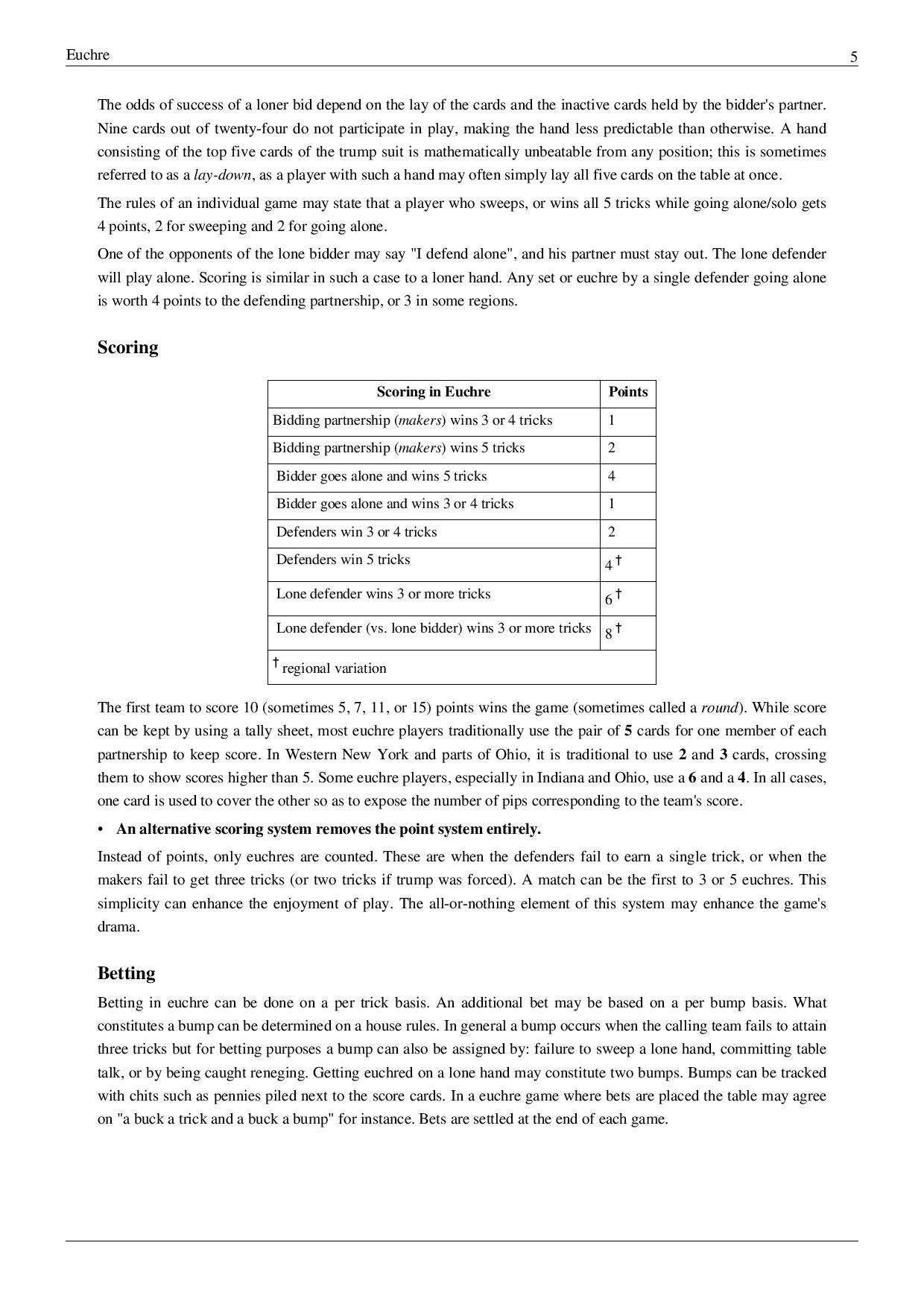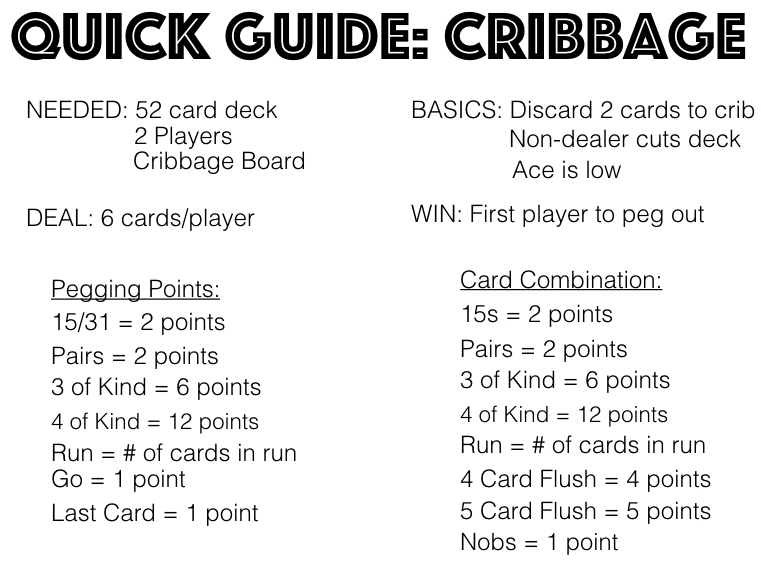Basic Rules Of Cribbage
See full list on learnplaywin.net. See full list on dummies.com. Cribbage is a stately race, advancing to the goal of 121 points by increments of one or two. Each player responds in turn to the other's moves, making game play more like conversation than combat.
| Cribbage BoardsCribbage PegsPersonalized PegsPlaying CardsBooks on CribbageOther GamesNew Products Toll Free: 1-877-MUGGINS (877-684-4467) E-Mail: |
|
Two to four people may play. These cribbage rules describe two-player cribbage. Rule variations for three- and four-player cribbage are given after the basic rules.
A cribbage board and a standard deck of 52 cards (jokers discarded). A typical cribbage board is show below.
The object of cribbage is to be the first player to score 121 points.
Cut the deck to determine who deals. Low card deals. Aces are low (one). For subsequent games, the loser deals.
The dealer deals 6 cards to each player.
The opponent puts two cards face-down into the dealer’s “crib”. The dealer also puts two cards face-down into the crib.
The opponent cuts the deck. The dealer takes one card off the deck at the cut point and places it face-up on the table. If this card is a jack, the dealer scores 2 points. This card will also be used later when scoring the hands.
The opponent starts by playing one card face-up on the table. Players alternate turns. On their turn, each player announces the cumulative value of the cards played. An ace is worth 1, face cards are worth 10, all others are worth their face value.
When a player cannot play a card without the cumulative total exceeding 31, that player says “go” and passes their turn. The other player then continues to play all the cards they can without exceeding 31. When no more cards can be played, the count restarts at 0 and play continues. The player who said “go” plays the first card. Players can’t use cards played in the previous run to 31 for scoring combinations in this new counting round.
Points are scored in cribbage as follows:
Pair, three-of-a-kind, four-of-a-kind:
If a player follows another player’s card with a card of the same value, that player scores 2 points. They commonly say “a pair is 2”. If a player plays a third card of the same value (three-of-a-kind), they score 6 points. A fourth card (four-of-a-kind) scores 12.
Run:
A run (a straight) of 3 or more cards scores 1 point per card. The cards do not have to run in order. For example, if the cards are played 7-5-6, the player who played the 6 scores 3 points for the run. The other player could then lay down a 4, for example, and score 4 points for a four-card run.
15:
If a player plays a card that brings the cumulative total to 15 exactly, they score 2 points. Reaching 31 exactly also scores 2 points.
Go:
When a player passes (says “go”), the other player scores 1 point.
31:
The player who plays the final card, without reaching a total of 31, scores 1 point.
Clarification on scoring a go: If the player who scores the go then plays a card to reach 31, they score one point for the go but only one additional point for reaching 31.
Example:
The cards are played 8-7-7-6. The dealer played the 8. Then the opponent played the 7 and scored 2 points because the total is 15. Then the dealer played the second 7 and scored 2 points for the pair. Then the opponent played the 6 and scored nothing (this is not a run because of the extra, intervening 7).
Next, the players score the cards in their hand. They use the cut card as part of their hand. The opponent goes first and the dealer last. The dealer will score the value of the cards in their hand, then separately score the value of the cards in the crib also using the cut card.
Here is how points are scored for this round of play:
Pair:
A pair scores 2 points. Three-of-a-kind scores 6. Four-of-a-kind scores 12.
Run:
A run of three or more cards scores 1 point per card.
15:
A combination of two or more cards that add up to 15 exactly scores 2 points.
Flush:
A four card flush in the hand (not in the crib and not including the cut card) scores 4 points. A five card flush including the cut card, in the hand or crib, scores 5.
His Nobs:
A jack of the same suit as the cut card (which is called His Nobs) scores 1 point.
Players may use the same card more than once to make multiple scoring combinations.
Example:
The player has 7-7-7-8 and the cut card is a 9. The player scores 6 for three-of-a-kind. He can make 15 three ways (7 plus 8) so scores another 6 points. Also the player can make three runs of 7-8-9 for 9 points. The player’s total score for this hand is 21 points.
For more assistance, see our cribbage scoring chart which lists the correct scores for most hard-to-count hands.
The winner is the first player to reach 121 points. If the loser fails to score at least 91 points, they are “skunked”. In match play, this is the equivalent of losing 2 games. If the player fails to score at least 61 points, they are “double-skunked”, which is the equivalent of losing 4 games. For scoring purposes, remember that the non-dealer counts their hand first. If they reach 121, the dealer can not count their points to try to avoid being skunked.
Deal five cards to each player and one to the crib. Each player then gives one card to the crib.

Deal five cards to each player. Each player then gives one card to the crib.
QUESTION:
When the players get to the last 5 holes at the end of the game, my friend plays that you can only peg out, and that you can’t count your cards if you’re in the last 5 holes. He says that you have to have the exact number to peg out and win! I’ve always played that when you’re in the STINK HOLE, which is the last hole only, that you can only peg out; that you can’t count your cards at that time. But he insists it starts at the last FIVE holes, and then you can only peg out, and you can’t count your hand if you are in those last five holes! Is there only a STINK HOLE or is there a LAST FIVE HOLE pegging only?
ANSWER:
In the most common rules, it doesn’t matter how you reach 121 points. You can peg out or count out. And you don’t need to reach 121 exactly. It’s okay to overshoot it. However, I have seen variations that require you to peg out if you are in the next to last hole. Your friend’s variation is new to me. But any variation is okay as long as players agree to it beforehand. For official tournament rules, refer to the American Cribbage Congress rules.
QUESTION:
In a run, is it possible to reverse a run for points? For example:
3-4-5-6-3
Basic Rules Of Euchre

3-4-5-6 = 4pts
Does 4-5-6-3 also get 4pts?
ANSWER:
No, you can’t reverse the run. In your example 3-4-5-6-3, you would count 8 points for two unique runs as follows:
3-4-5-6 (using one 3) for 4 points
3-4-5-6 (using the other 3) for another 4 points
QUESTION:
Basic Rules Of Cribbage For Dummies
I need your help on the rules of crib, in particular the cutting of the deck to determine who deals first. If the two cards cut are both picture cards is it the lowest picture card wins or are they both classed as a ten card? Please help settle an arguement.

What Are The Rules Of Cribbage
ANSWER:
Normal card rank applies. For example, on person cuts a Jack and the other a Queen. The Jack deals. Also remember that Aces are low.
Printable Basic Rules Of Cribbage
Sometimes written rules can be a little confusing. For a visual explanation of the rules to Cribbage, watch the video below.